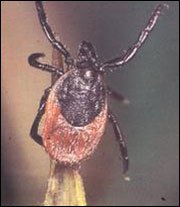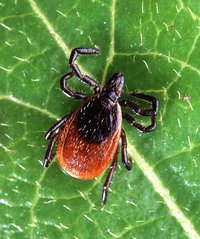Ticks and Mites
|
|
| Ticks | ||||||||
|---|---|---|---|---|---|---|---|---|
 | ||||||||
| Scientific classification | ||||||||
| ||||||||
| Families | ||||||||
Tick is the common name for the small wingless arachnids that, along with mites, comprise the order Acarina. Ticks are external parasites, living off the blood of mammals, birds, and occasionally reptiles and amphibians.
| Contents |
Characteristics
Tick_(aka).jpg
The major families of tick include the Ixodidae or hard ticks, which have thick outer shells made of chitin, and Argasidae or soft ticks, which have a membraneous outer surface. Soft ticks typically live in crevices and emerge briefly to feed, while hard ticks will attach themselves to the skin of a host for long periods of time.
Ticks can transmit human diseases such as relapsing fever, Lyme disease, Rocky Mountain spotted fever, tularemia, equine encephalitis and several forms of ehrlichiosis. Additionally, they are responsible for transmitting livestock diseases, including babesiosis and anaplasmosis. Generally, tick-borne diseases correspond to a specific tick-host combination, and are limited in their geographical extent.
Location
Tick_male_(aka).jpg
Ticks are often found in tall grass, where they will rest themselves at the tip of a blade so as to attach themselves to a passing animal or human. It is a common misconception that the tick can jump from the plant onto the host. Physical contact is the only method of transportation for ticks. They will generally drop off of the animal when full, but this may take several days. Ticks contain a structure in their mouth area that allows them to anchor themselves firmly in place while sucking blood. Pulling a tick out forcefully may squeeze contents of the tick back into the bite and often leaves the mouthpiece behind, which may result in infection. Methods for removing a tick without it leaving its mouthpiece inside the skin include anesthetizing the tick with a substance such as ether.
Facts
Tick_male_size_comparison_(aka).jpg
- Dermacentor variabilis, the American dog tick, is perhaps the most well-known of the North American hard ticks.
- Ixodes dammini, the deer tick, is common to the eastern part of North America and is known for spreading Lyme disease.
- I. pacificus lives in the western part of the continent and is responsible for spreading Lyme disease and the more deadly Rocky Mountain spotted fever. It tends to prefer livestock as its adult host.
Life cycle
Deer (black-legged) tick
The deer (or black-legged) tick, and the related western black-legged tick, are the primary known transmitters of Lyme disease in the United States. Both are hard-bodied ticks with a two-year life cycle. Like all species of ticks, deer ticks and their relatives require a blood meal to progress to each successive stage in their life cycles.
The life cycle of the deer tick comprises three growth stages: the larva, nymph and adult. In both the northeastern and mid-western U.S., where Lyme disease has become prevalent, it takes about two years for the tick to hatch from the egg, go through all three stages, reproduce, and then die. A detailed description of this life cycle and the seasonal timing of peak activity, as they occur in these regions, is provided below.
Larva
Eggs laid by an adult female deer tick in the spring hatch into larvae later in the summer. These larvae reach their peak activity in August. No bigger than a newsprinted period, a larva will wait on the ground until a small mammal or bird brushes up against it. The larva then attaches itself to its host, begins feeding, and engorges with blood over several days.
If the host is already infected with the Lyme disease spirochete from previous tick bites, the larva will likely become infected as well. In this way, infected hosts in the wild (primarily white-footed mice, which exist in large numbers in Lyme-endemic areas of the northeast and upper mid-west) serve as spirochete reservoirs, infecting ticks that feed upon them. Other mammals and ground-feeding birds may also serve as reservoirs.
Because deer tick larvae are not born infected, it is believed that they cannot transmit Lyme disease to their human hosts. Instead, "reservoir" hosts, as mentioned above, can infect the larvae. Having already fed, an infected larva will not seek another host, human or otherwise, until after it reaches the next stage in its life cycle. It is not completely known whether larvae, in themselves, pose a threat to humans or their pets.
Nymph
Most larvae, after feeding, drop off their hosts and molt, or transform, into nymphs in the fall. The nymphs can remain active throughout the winter and early spring.
In May, nymphal activity begins. Host-seeking nymphs wait on vegetation near the ground for a small mammal or bird to approach. The nymph will then latch on to its host and feed for 4 or 5 days, engorging with blood and swelling to many times its original size. If previously infected during its larval stage, the nymph may transmit the Lyme disease spirochete to its host. If not previously infected, the nymph may become infected if its host carries the Lyme disease spirochete from previous infectious tick bites. In highly endemic areas of the northeast, at least 25% of nymphs have been found to harbor the Lyme disease spirochete.
Too often, humans are the hosts that come into contact with infected nymphs during their peak spring and summer activity. Although the nymphs' preferred hosts are small mammals and birds, humans and their pets are suitable substitutes. Because nymphs are about the size of a poppy seed, they often go unnoticed until fully engorged, and are therefore responsible for the majority of human Lyme disease cases.
Adult
Once engorged, the nymph drops off its host into the leaf litter and molts into an adult. These adults actively seek new hosts throughout the fall, waiting up to 3 feet above the ground on stalks of grass or leaf tips to latch onto deer (its preferred host) or other larger mammals (including humans, dogs, cats, horses, and other domestic animals). Peak activity for adult deer ticks occurs in late October and early November. Of adults sampled in highly endemic areas of the northeast, at least 50% have been found to carry the Lyme disease spirochete.
As winter closes in, adult ticks unsuccessful in finding hosts take cover under leaf litter or other surface vegetation, becoming inactive when covered by ice and snow. Generally, winters in the northeast and upper mid-west are cold enough to keep adult ticks at bay until late February or early March but not when temperatures begin to rise. At this time, they resume the quest for hosts in a last-ditch effort to obtain a blood meal allowing them to mate and reproduce. This second activity peak typically occurs in March and early April.
Adult female ticks that attach to deer, whether in the fall or spring, feed for approximately one week. Males feed only intermittently. Mating may take place on or off the host, and is required for the female's successful completion of the blood meal. The females then drop off the host, become gravid, lay their eggs underneath leaf litter in early spring, and die. Each female lays approximately 3,000 eggs. The eggs hatch later in the summer, beginning the two-year cycle anew.


